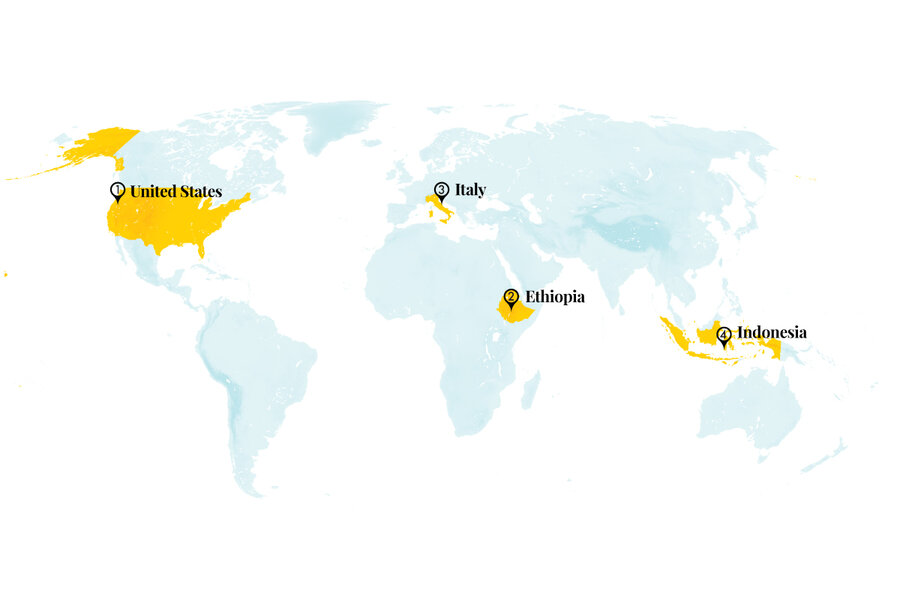Small actions add up to benefit ocean habitats and animals
Loading...
Along with environmental news, we look at how nonprofit organizations can sustainably empower residents in need of affordable housing, and how child laborers can be supported before returning to regular classrooms.
1. United States
An overlooked approach to housing is giving more low-income residents the chance to own a home. In Springfield, Oregon, the nonprofit affordable housing developer SquareOne Villages and architecture firm Cultivate Inc. opened the C Street Co-op to residents last fall. The six-unit apartment complex is a limited-equity cooperative, which means each inhabitant is a partial owner of the building. Members pay $10,000 at the outset for a one-bedroom unit, and then $788 per month, utilities and maintenance included. Increases in the property’s resale value are capped at 3% per year. SquareOne owns 10 acres of land through a community land trust across six sites, including a 22-unit tiny home co-op in Eugene.
Why We Wrote This
Here are examples of how persistence and small changes make a difference. In Indonesia, women are replanting whole mangrove forests by hand. And in Baja California, green LED lights on fishing nets help reduce bycatch.
Those involved say there will be more opportunities to scale up the models: Oregon in 2019 passed the country’s first law that ends single-family zoning in medium and large cities, with a June deadline for cities to update their own rules. Across the U.S., there are around 250,000 households that operate as shared-equity units, although finding lenders to finance the relatively small mortgages can present a challenge. “It’s the permanent affordability that means everything,” said Silvia Salazar, a resident of a limited-equity co-op in Washington, D.C. “No matter how much our community gentrifies, we don’t have to worry about displacement.”
Eugene Weekly, The New York Times
2. Ethiopia
Speed schools in Ethiopia give children who aren’t in school another opportunity to restart their education. When families need help with house or field work, children often drop out of school to pitch in. Around 2.2 million Ethiopian children are currently out of school, a problem exacerbated by war, drought, and flooding. An accelerated learning program called Luminos Second Chance is a steppingstone to help students catch up. “For children who’ve been in a laboring environment, that sense of empowerment, that sense of safety that comes from being in a warm, welcoming classroom is a powerful entry point back into the school system,” said Caitlin Baron, who runs the nonprofit Luminos Fund.
Students spend 10 months covering material taught in the first three years of school, providing a foundation for them to rejoin regular classes in the third or fourth grade. Bright, decorated spaces and a focus on music and games encourage a sense of joy. So far, Luminos has reached nearly 140,000 students in Ethiopia, and in 2016 the government began replicating the model in schools across the country. While literacy rates still have room for improvement, primary school enrollment tripled between 2000 and 2016.
Thomson Reuters Foundation
3. Italy
Italy revised its constitution to include environmental protection. The amendments, passed Feb. 8, hold the state accountable for safeguarding ecosystems and biodiversity and stipulate that economic activity must not harm the natural world. Environmentalists praised the move but acknowledged that constitutional laws don’t always live up to expectations. While concrete results remain to be seen, the “strong and symbolic act,” as Minister of Ecological Transition Roberto Cingolani called it, helps Italy lay out “well-defined rules’’ to guide the country forward.
To ensure the law is applied in practice, lower courts can appeal to the Constitutional Court in cases where it isn’t being upheld, and the head of state can veto bills that don’t align with the constitution. The European commissioner for the environment, Virginijus Sinkevičius, congratulated the country on Twitter: “This is a major step Italy! By choosing to protect the environment, biodiversity, and ecosystems through your constitution, you are choosing to protect future generations!”
Reuters, Earth.org
4. Indonesia
A women-led collective is restoring mangrove swamps around Indonesia’s Tanakeke Islands. The gnarled saltwater trees protect coastal communities from extreme weather while also acting as an important carbon sink. Indonesia has the world’s largest concentration of “blue carbon” habitats, but it has lost almost half of its mangroves in the last 30 years, to make room for shrimp and fish farms. “Womangrove” is one of various groups across the country stepping up to revive native mangrove forests.
The collective was formed in 2015 by around 20 women with the help of international donors. By replanting over 110,000 mangroves, the group is rejuvenating a local ecosystem, and some participants are now harvesting shellfish that live among the trees. While the business side of the initiative presents logistical and financial challenges, the group’s restoration work remains strong, with support from the Indonesian nonprofit Blue Forest Foundation. Some of the women have become local leaders, and all of them are helping shift the local mentality toward protecting the mangroves. “There is an emerging awareness of how important it is,” said one member of Womangrove. “Women play a very important role in this because it is closely related to everyday life.”
Mongabay
Oceans
Simple LED lights are saving wildlife from fishing nets. Large gill nets are commonly used for commercial fishing, but these walls of mesh that hang in the ocean are notorious for bringing in unwanted “bycatch,” including species like dolphins, sea turtles, sharks, and squids. So Jesse Senko of Arizona State University and his team partnered with small-scale fishers from Baja California, Mexico, to test the effectiveness of nets dotted with green lights in 10-meter increments.
In comparison with regular nets, the lighted nets trapped 63% less bycatch overall, ranging from 51% fewer turtles to 95% fewer sharks. Some sea creatures avoid the lights or the nets better than others, perhaps thanks to more sophisticated eyesight. By reducing undesirable catches, fishers also spent less time hauling in and detangling nets. Smaller fishers may find the current price of equipping a net with battery-powered lights prohibitive at up to $140, but Dr. Senko and his team are testing a solar light to help make the illuminated nets easier to use.
Science









